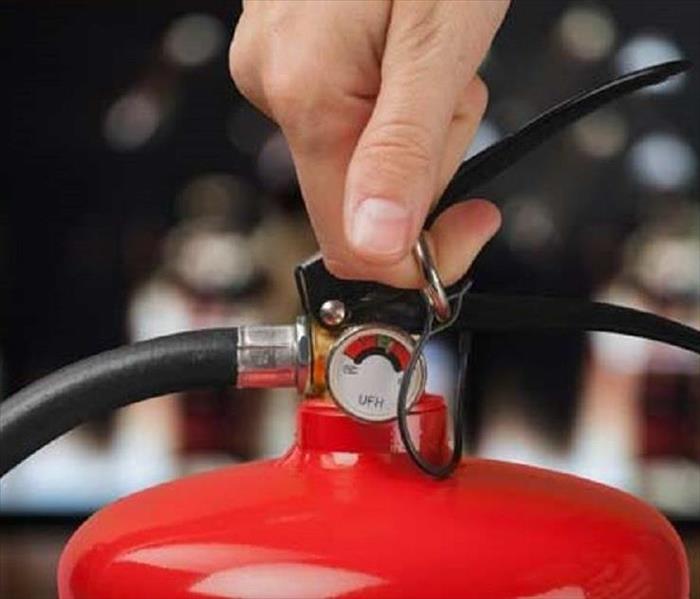3 Minutes on Fire Extinguishers
6/29/2018 (Permalink)
f you find yourself dealing with a fire in your kitchen in the future, you’ll be glad you took the 3 minutes to read this post and learn the best fire extinguisher for kitchen fires.
We’re taking the time to write this blog because all fire extinguishes aren’t created equally – and neither are the fires they put out. It’s important to know the different types of fire extinguishers, how they’re used, and some of the best types of fire extinguishers for kitchen are so you’re prepared in case of an emergency.
Keep in mind this information is provided to help you deal with small grease fires in the kitchen, preferably while someone else is calling the fire department to your home.
Different Classifications of Fire Extinguishers
Household fire extinguishers have different classifications that tell you what type of fire they are capable of putting out. If you use the wrong class on a fire, you could make the situation worse. Luckily, fire extinguishers are clearly labeled.
Class A: For trash, wood, and/or paper fires.
Class B: For liquids and/or grease fires.
Class C: For electrical fires.
Class D: For flammable metals (usually only needed in labs or industrial plants).
Class K: Specifically for kitchen fires when grease and oil are involved.
Note, some fire extinguishers may be rated in more than one class which means you can use them on different types of fires.
What Size Kitchen Fire Extinguisher Do You Need?
There are several sizes of extinguishers to choose from. How do you know what size makes the best fire extinguisher for kitchen use? It’s a pretty easy choice once you know the recommendations based on the sizes.
Classes A and B also have a number before the letter that tell you basically how much fire it can handle.
For Class A extinguishers, the number (from 1 to 40) represents the equivalency for gallons of water. 1 is equal to 1.25 gallons of water, so a 3 rated extinguisher is the same as 3.75 gallons of water.
For Class B extinguishers, the rating goes from 1 to 640 and it represents square footage a fire can handle. 20B means you’ll be able to handle a fire that’s spread to cover 20 square feet.
For Class C, D, and K, there are no numbers, so you’ll use the numbers from the A and B ratings to choose your extinguisher.
Keep in mind that the extinguisher size also varies based on the weight. Typically, there are 4 lbs, 5 lbs, 10 lbs, and 20 lbs extinguishers. Bigger isn’t always better here – if you can’t pick up the extinguisher and sweep it to put out the fire because the device is too heavy, you’ll wish you chose the 5 or 10 pounder instead of the 20. Note: extinguishers are heavier than their displayed weight when fully charged.
PASS: How to Use a Fire Extinguisher
Knowing what fire extinguisher to use based on the type of fire you’re dealing with is only half the battle. You also need to know how to use a fire extinguisher. A good way to remember what to do in a moment of panic is the acronym P.A.S.S. It stands for:
Step 1: Pull the pin.
Step 2: Aim the extinguisher at the kitchen fire low with the nozzle at the base of the fire.
Step 3: Squeeze the handle to begin extinguishing the fire.
Step 4: Sweep the extinguisher side to side at the fire’s base until it’s out. Be careful of re-ignition.
5 of the Best Fire Extinguishers for Kitchens
Some of our favorite fire extinguishers for kitchen fires are:
- Amerex B500 Rechargeable 5-lb Extinguisher: Weighs under 10 pounds fully charged and works with all three classes of home fires.
- WilliamsRDM Stovetop Firestop Extinguisher: This kitchen fire extinguisher is mounted above your stove and activates when it detects fires. It uses baking soda and installs flawlessly via a magnet. You’ll need to purchase another extinguisher to have on hand for other types of fires that happen away from the stovetop.
- Kidde 466112 Pro Dry Chemical Fire Extinguisher: This extinguishers discharges in fifteen seconds or less and has a range up to fifteen feet. It’s suitable for Class A, B, and C fires, is very durable, and weighs under 10 pounds. Note: Kidde recalled extinguishers with plastic handles, but this one wasn’t part of the recall.
- First Alert Rechargeable Standard Home Fire Extinguisher: All metal and suitable for A, B, and C class fires and rechargeable (by a professional) if you have to use it.
- First Alert Fire Extinguishing Spray: One-time use, lightweight, and biodegradable, this fire extinguisher discharges for 32 seconds in a fine mist that’s easy to clean. You’ll want to keep a standard extinguisher on hand because this one is small and only single-use.
We hope you found this post about the best type of fire extinguisher for kitchen fires useful and are ordering your fire extinguishers to go in multiple rooms in your home if you don’t already have them. Remember, SERVPRO of North Cabarrus County and China Grove is here for all of your flood, fire, and mold cleanup and reconstruction. Contact us today.
704-939-1944






 24/7 Emergency Service
24/7 Emergency Service
